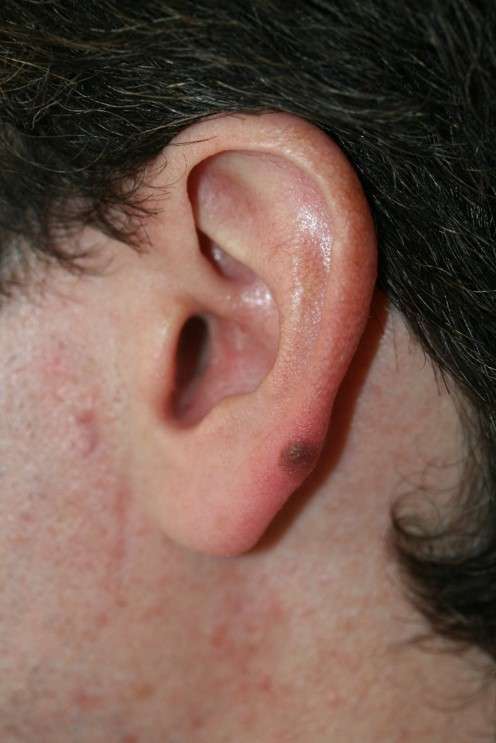There are three main types of skin cancer: basal cell carcinoma, squamous cell carcinoma, and melanoma. Basal cell and squamous cell cancers usually occur on sun-exposed areas of the body, such as the face, neck, hands, and arms. Melanoma can occur anywhere on the body but is most likely to develop in areas that have been exposed to the sun.
Skin cancers on the ear typically fall into one of these three categories. Basal cell carcinomas may appear as small bumps or scaly patches on the ear. Squamous cell carcinomas may appear as raised bumps or growths with a rough surface.
Melanomas may appear as changes in an existing mole or as a new dark spot on the ear.
Most people think of skin cancer as something that only occurs on the face or neck, but it can actually occur anywhere on the body – including the ear. Skin cancer on the ear is relatively rare, but it does happen. The most common type of skin cancer that occurs on the ear is basal cell carcinoma.
This type of cancer usually appears as a small, slow-growing bump on the ear. It may be pink, red, or brown in color, and it may bleed or crust over occasionally. If you notice any unusual growths on your ears (or anywhere else on your body), it’s important to see a doctor right away so that they can rule out skin cancer.
External ear (& skin cancer)
Skin Cancer on Ear Symptoms
Skin cancer is the most common type of cancer. It is also one of the most preventable types of cancer. Skin cancer on ear symptoms can include a change in the color or texture of the skin, a new growth or lump, and itching or bleeding.
The best way to prevent skin cancer is to avoid sun exposure and to wear sunscreen when outdoors.
Skin Cancer on Ear Treatment
Skin cancer is the most common type of cancer. The two most common types are basal cell carcinoma and squamous cell carcinoma. They usually form on the sun-exposed skin of the head, face, neck, hands, and arms.
But they can occur anywhere on your body.
Basal cell carcinomas (BCCs) are slow-growing tumors that arise from the basal cells in the lower part of the epidermis (the outermost layer of skin). BCCs are almost always curable if found early and treated promptly.
Squamous cell carcinomas (SCCs) also begin in the epidermis but tend to grow faster than BCCs. SCCs can metastasize (spread) to other parts of the body, so prompt treatment is important.
If you have any suspicious growths on your skin, it’s important to see a dermatologist for evaluation.
Skin cancer can often be cured if found early and treated properly.
Skin Cancer on Ear Pictures
Skin cancer can develop on any part of the body, including the ear. Though it’s less common for skin cancer to occur on the ear than other parts of the body, it’s still important to be aware of the signs and symptoms so you can catch it early.
The most common type of skin cancer that develops on the ear is basal cell carcinoma.
This type of skin cancer usually appears as a small, pearl-shaped growth that is flesh-colored or white. It can also look like a flat, scaly patch that is slightly darker than the surrounding skin. Basal cell carcinomas are usually slow-growing and rarely spread to other parts of the body.
However, if left untreated, they can become large and disfiguring.
Squamous cell carcinoma is another type of skin cancer that can occur on the ear. This type of skin cancer usually appears as a firm, red bump that may bleed or crust over.
Squamous cell carcinomas can also spread to other parts of the body if left untreated, so it’s important to see a doctor if you notice any suspicious growths on your ears.
Skin Cancer on Ear Cartilage
Skin cancer on the ear is not as common as skin cancer on other parts of the body, but it can still occur. The most common type of skin cancer on the ear is squamous cell carcinoma, which starts in the thin, flat cells that make up the outer layer of skin. Basal cell carcinoma, another type of skin cancer, can also occur on the ear, but it is less common.
Melanoma, the most dangerous type of skin cancer, can also develop on the ear cartilage, but this is even less common.
If you notice any changes in your ear cartilage, such as a growth or change in color, it’s important to see a doctor right away. Skin cancer on the ear can be treated successfully if caught early.
Can Ear Cancer Kill You
Cancer is a scary word. We all know that it can be deadly, but we often think of it as something that happens to other people. Unfortunately, cancer doesn’t discriminate and anyone can be diagnosed with this disease.
While there are many different types of cancer, today we’re going to focus on ear cancer.
Ear cancer is a relatively rare type of cancer, but that doesn’t make it any less dangerous. In fact, if left untreated, ear cancer can be fatal.
The good news is that when caught early, ear cancer is highly treatable and the prognosis is good.
So what exactly is ear cancer? Ear cancer occurs when abnormal cells grow in the tissues of the ear.
These cells can form tumors which can then spread to other parts of the body if left unchecked. There are two main types of ear cancers – squamous cell carcinoma and adenocarcinoma . Squamous cell carcinoma makes up about 95% of all ear cancers while adenocarcinoma represents only 5%.
Symptoms of ear cancer include:
· A feeling of fullness in the affected ear
Ear Cancer Symptoms
Most people are unaware that ear cancer even exists. The symptoms of ear cancer can be very subtle and easily overlooked. If you experience any of the following symptoms, please see your doctor immediately:
1. A feeling of fullness or pressure in the ear
2. Ear pain that does not go away
3. Drainage from the ear that is bloody or pus-like
4. Hearing loss in one ear that does not improve with time
Ear Cartilage Cancer Pictures
If you’re looking for pictures of ear cartilage cancer, you’ve come to the right place. Here at Ear Cartilage Cancer Pictures, we have a wide selection of images that can help you better understand this rare form of cancer.
Ear cartilage cancer is a type of tumor that develops in the cartilage of the ear.
This type of cancer is very rare, accounting for only about 1% of all tumors that develop in the head and neck region. While most ear cartilage cancers are non-cancerous (benign), some can be quite aggressive and may spread to other parts of the body if left untreated.
There are several different types of ear cartilage cancer, each with its own set of symptoms and treatment options.
The most common type is squamous cell carcinoma, which typically appears as a small growth or lump on the outer ear. Other types include adenocarcinoma, chondrosarcoma, and malignant melanoma.
Ear cartilage cancer can be difficult to diagnose due to its rarity and lack of symptoms in its early stages.
Squamous Cell Carcinoma (Ear Pictures)
If you have any questions about squamous cell carcinoma, don’t hesitate to ask your doctor. In the meantime, here are some pictures of this type of cancer to give you a better idea of what it looks like.

Credit: www.earreconstruction.co.uk
What Does Skin Cancer on Ears Look Like?
Skin cancer on the ears can present in a few different ways. The most common type of skin cancer on the ear is squamous cell carcinoma, which typically appears as a painless, scaly growth or sore that bleeds easily. Basal cell carcinoma, another type of skin cancer that can occur on the ears, usually looks like a small, flesh-colored or pink bump.
Melanoma, the third and most serious type of skin cancer, may appear as a dark mole or growth on the ear. While any suspicious growth or change in the appearance of your ears should be checked out by a doctor, keep an eye out for these specific signs of skin cancer.
What Does the Beginning of Ear Cancer Look Like?
There are several different types of ear cancer, each with its own set of symptoms. However, there are some general signs that may be indicative of ear cancer, including:
-A lump or mass in the ear canal
-Persistent pain in the ear
-Drainage from the ear
-Hearing loss
-Tinnitus (ringing in the ears)
-Vertigo (a spinning sensation)
These symptoms can also be caused by other conditions, so it’s important to see a doctor if you’re experiencing any of them.
A diagnosis can only be made through a medical examination and testing.
How Do You Treat Skin Cancer on Ear?
If you have skin cancer on your ear, there are a few different treatment options available to you. Your doctor will likely recommend surgery to remove the cancerous tissue. This can be done in a number of ways, depending on the size and location of the tumor.
If the tumor is small and confined to the outermost layer of skin, it can often be removed with a simple excision. Larger tumors may require more extensive surgery, such as Mohs micrographic surgery or skin flap surgery. In some cases, radiation therapy may be used to kill cancer cells and shrink tumors.
Chemotherapy may also be an option, though this is typically only recommended for advanced cases of skin cancer.
What Does Basal Cell Carcinoma Look Like on the Ear?
Basal cell carcinoma (BCC) is the most common type of skin cancer. It usually appears as a small, pale patch on the skin that may be crusted or scaly. BCC can also appear as a raised bump that is pink, red, or pearly in color.
The ear is a common site for BCC, and it often looks like a growth or sore that does not heal. Left untreated, BCC can grow larger and invade nearby tissues. In rare cases, it can spread to other parts of the body.
If you notice any changes in your skin, especially on the ear, you should see a dermatologist for an evaluation.
Conclusion
Skin cancer is the most common type of cancer. It can develop on any part of the body, but is most commonly found on the face, neck, and hands. The ears are also a common site for skin cancer, particularly in people who have fair skin or who have been exposed to ultraviolet (UV) light for long periods of time.
Skin cancer on the ear can take several different forms, but the most common type is basal cell carcinoma. This form of skin cancer usually appears as a small, round, flesh-colored bump that may bleed easily if scratched or damaged. If left untreated, basal cell carcinoma can grow larger and eventually invade nearby tissues.
Treatment for basal cell carcinoma typically involves surgery to remove the tumor and some surrounding tissue.
